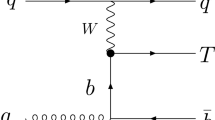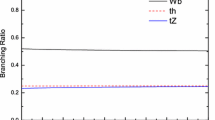Abstract
In a simplified model including an SU(2) singlet T quark with charge 2/3, we investigate the single vector-like T production at the high energy \(e\gamma \) collision. We study the observability of the vector-like T focusing on the \(T\rightarrow Wb\) decay channel with \(W\rightarrow l\bar{\nu }\) at \(\sqrt{s}=2.0\) TeV. In this analysis, only two free parameters are involved, namely the T quark coupling strength for single production \(g^{*}\) and the mass \(m_{T}\). We scan the parameter space and find that the correlation region of \(g^{*}\in [0.24, 0.5]\) and \(m_{T}\in [800, 1360]\) GeV can be excluded with integrated luminosity \(L=100\,\hbox {fb}^{-1}\) and the correlation region of \(g^{*}\in [0.13, 0.5]\) and \(m_{T}\in [800, 1620]\) GeV can be excluded with integrated luminosity \(L=1000 \,\hbox {fb}^{-1}\) at \(2\sigma \) level.
Similar content being viewed by others
Avoid common mistakes on your manuscript.
1 Introduction
A number of theories beyond the Standard Model (SM) offer mechanisms to resove the quadratic divergences that arise from the radiative corrections to the Higgs boson mass so as to solve the naturalness problem [1]. One solution is to introduce vector-like quarks (VLQs) [2, 3], defined as hypothetical spin-1/2 coloured particles whose left- and right-handed components have the same transformation properties under the SM gauge group. VLQs could dampen the unnaturally large quadratic corrections to the Higgs boson mass by contributing significantly to loop corrections. They appear in many scenarios, such as extra dimensions [4, 5], little Higgs [6,7,8,9,10] and composite Higgs models [11, 12]. In this analysis, we focus on a simplified model including the SU(2) singlet vector-like top quark (T).
Recently, the direct searches for the vector-like T at 13 TeV LHC have been performed by ATLAS [13] and CMS [14] Collaborations relying on signatures induced by both the vector-like T pair-production and single-production modes, corresponding to an integrated luminosity of about 36 \(\hbox {fb}^{-1}\). Assuming 100% branching ratio to Wb, the observed (expected) 95% CL lower limits on the T mass are 1350 GeV (1310 GeV). Assuming 100% branching ratio to Zt, the observed (expected) 95% CL lower limits on the T mass are 1160 GeV (1170 GeV).
Compared to the complicated QCD background at the LHC, the lepton colliders can offer much cleaner experimental environment. Some design schemes have been put forward, such as the International Linear Collider (ILC) [15, 16] and the Compact Linear Collider (CLIC) [17, 18], they can run at the center of mass (c.m.) energy ranging from 500 GeV to 3 TeV. Along with \(e^{+}e^{-}\) collision, other options such as \(\gamma \gamma \) and \(e\gamma \) collider modes [19,20,21,22,23] can also be realized by the backward Compton scattering of incident electron- and laser-beams. Each option for colliders will provide interesting topics to study, here we will focus on the search for the single vector-like T production at \(e\gamma \) collision, which will allow unique opportunity to investigate the vector-like top quark.
The paper is organized as follows. In Sect. 2 we give a brief description of the simplified model including the vector-like T with charge 2/3. In Sect. 3 we investigate the signal and discovery potentiality of the vector-like T in the Wb channel at the \(e\gamma \) collision. Finally, we draw our conclusions in Sect. 4.
2 Top partner in a simplified model
Recently, a generic parametrization of an effective Lagrangian for top partners has been proposed in [24], where the vector-like quarks are embedded in different representations of the weak SU(2) group. Here, we focus on the simplified case that the heavy vector-like T quark of charge 2/3 is an SU(2) singlet, with couplings only to the third generation of SM quarks. The results based on this simplified effective theory can be used to make predictions for more complex models including various types of top partners. The general effective Lagrangian of the top partner sector can be described by
where \(m_T\) is the top partner mass and \(g^{*}\) parametrizes the single production coupling associated with the SM quarks. g is the \(SU(2)_L\) gauge coupling constant, \(c_{W}=\cos \theta _W\) and \(\theta _W\) is the Weinberg angle. In this simplified model, there are only two free parameters, i. e. the top partner mass \(m_T\) and the coupling parameter \(g^{*}\).
Generally, the top partner couplings to the SM particles are severely constrained by electroweak precision physics as well as by the direct measurement of \(V_{tb}\) [25]. However, such constraints can be altered significantly in most realistic models including the vector-like quark with two or more partner multiplets [26,27,28,29,30,31,32,33]. Here we take a conservative limit for the coupling parameter \(g^{*}\le 0.5\), which is consistent with the current experiment bounds [34].
The vector-like T quark has three possible decay modes: \(T\rightarrow ht\), \(T\rightarrow Zt\) and \(T\rightarrow Wb\), and their branching ratios are shown in Fig. 1. For \(m_{T} > 800\) GeV, the branching ratios \(Br(T\rightarrow ht)\approx Br(T\rightarrow Zt) \approx \dfrac{1}{2} Br(T \rightarrow Wb)\) is a good approximation as expected by the Goldstone boson equivalence theorem [35].
3 Event generation and discovery potentiality
In Fig. 2, we show the leading order Feynman diagram of the process \(e^{-}\gamma \rightarrow \nu _{e}b\bar{T}\).
We extract the model file [36] of the singlet vector-like top partner by using the package FeynRules [37]. Then, we use MadGraph 5 [38] to calculate the leading order cross sections of the process \(e^{-}\gamma \rightarrow \nu _{e}b\bar{T}\). We scan over the free parameters \(m_{T}\) and \(g^{*}\) within the region \(m_{T}\in [800, 1800]\) GeV and \(g^{*}\in [0.0, 0.5]\), and take the SM parameters as follows [39]
In Fig. 3, we show the cross sections \(\sigma \) on the \(g^{*}\sim m_{T}\) plane at the c.m. energy \(\sqrt{s}=2.0\) TeV. We can see that the cross sections decreases with the increase of the top partner mass \(m_{T}\) and increases with the increase of the coupling parameter \(g^{*}\). In the favorable parameter space, the cross sections can reach more than 10 fb.
In next section, we will perform the Monte Carlo simulation and explore the discovery potentiality of top partner T through the channel
which implies that the events contain one isolated charged lepton \(l^{-}(l=e,\mu )\), two b-jets and missing transverse energy \(\not \!\!\!E_{T}\).
For this signal, the most relevant backgrounds come from \(\nu _{e}b\bar{t}, \nu _{e}WZ\) and \(\nu _{e}Wh\). We generate the signal and background events by using MadGraph 5 and perform the parton shower and hadronization with PYTHIA [40]. The fast detector simulations are performed with Delphes [41], where the b-jet tagging efficiency and other basic cuts are taken as default value in delphes_card_ILD of ILC. FastJet [42] is used to cluster the jets by choosing the anti-\(k_{t}\) algorithm [43] with distance parameter \(\Delta R =0.4\).
Taking into account the current constraints, we take \(m_{T}=900,1000,1100\) GeV and \(g^{*}=0.3\) for three benchmark points. In order to suppress the backgrounds, we impose the following cuts
where \(M_{T}(b_{1},l)\) is the transverse mass of the \(b_{1}l\) system and \(M_{b_{1}b_{2}}\) is the invariant mass of two b-jets.
We use MadAnalysis 5 [44, 45] for analysis and summarize the cut-flow cross sections of the signal and backgrounds for the three benchmark points at \(\sqrt{s}=2.0\) TeV in Table 1. From the numerical results, we can see that the backgrounds are suppressed efficiently after imposing the selected cuts. The total cut efficiency of the signal can reach \(24.5\%\), \(28\%\), \(30\%\) for \(m_{T}=900,1000,1100\) GeV, respectively.
To estimate the observability quantitatively, we calculate the statistical significance (SS) by using Poisson formula [46]
where S and B are the signal and background cross sections and L is the integrated luminosity. Here, we have assumed the background uncertainty is negligible, which is the reason why it is possible to multiply by the luminosity L in front of the whole term in square brackets.
In order to investigate the top partner signal more comprehensively, we show the excluded regions depending on integrated luminosity at \(2\sigma \) and \(3\sigma \) level on the \(g^{*}\sim m_{T}\) plane for \(\sqrt{s}=2.0\) TeV in (Fig. 4), where the conservative cut efficiency 25% of the signal is chosen. At \(2\sigma \) level, we can see that the correlation region of \(g^{*}\in [0.24, 0.5]\) and \(m_{T}\in [800, 1360]\) GeV can be excluded with integrated luminosity \(L=100\) \(\hbox {fb}^{-1}\). If the integrated luminosity can be raised to \(L=1000\,\hbox {fb}^{-1}\), the excluded region will expand into \(g^{*}\in [0.13, 0.5]\) and \(m_{T}\in [800, 1620]\) GeV. If the \(3\sigma \) evidence level is required, the higher integrated luminosity is needed to achieve the same excluded regions. Obviously, we can set the lower limits on the coupling parameter \(g^{*}\) according to the observed limits of the vector-like T mass and vice versa.
4 Conclusions
In this paper, we study the single production of the vector-like top partner at the \(e\gamma \) collision. In order to be as model-independent as possible, we exploited a simplified model, where the vector-like top partner is an SU(2) singlet with charge 2/3. Under the current constraints, we calulate the cross section and investigate the observability of the T through the channel \(e^{-}\gamma \rightarrow \nu _{e}b\bar{T}\rightarrow \nu _{e}b W^{-}(\rightarrow l^{-}\bar{\nu _{l}})\bar{b}\) at \(\sqrt{s}=2.0\) TeV. We find that the correlation region of \(g^{*}\in [0.24, 0.5]\) and \(m_{T}\in [800, 1360]\) GeV can be excluded corresponding to an integrated luminosity \(L=100\,\hbox {fb}^{-1}\) at \(2\sigma \) level. If the integrated luminosity can reach \(L=1000\,\hbox {fb}^{-1}\), the excluded region will expand into \(g^{*}\in [0.13, 0.5]\) and \(m_{T}\in [800, 1620]\) GeV.
References
L. Susskind, Phys. Rev. D 20, 2619 (1979)
J.A. Aguilar-Saavedra, R. Benbrik, S. Heinemeyer, M. Prez-Victoria, Phys. Rev. D 88, 094010 (2013)
L. Panizzi, Nuovo Cim. C 037, 69 (2014)
L. Randall, R. Sundrum, Phys. Rev. Lett. 83, 3370 (1999)
H.-C. Cheng, B.A. Dobrescu, C.T. Hill, Nucl. Phys. B 589, 249 (2000)
N. Arkani-Hamed, A.G. Cohen, E. Katz, A.E. Nelson, JHEP 07, 034 (2002)
N. Arkani-Hamed, A.G. Cohen, E. Katz, A.E. Nelson, T. Gregoire, J.G. Wacker, JHEP 08, 021 (2002)
M. Schmaltz, Nucl. Phys. Proc. Suppl. 117, 40 (2003)
M. Schmaltz, D. Tucker-Smith, Ann. Rev. Nucl. Part. Sci. 55, 229 (2005)
H.-C. Cheng, I. Low, L.-T. Wang, Phys. Rev. D 74, 055001 (2006)
D. Marzocca, M. Serone, J. Shu, JHEP 08, 013 (2012)
K. Agashe, R. Contino, A. Pomarol, Nucl. Phys. B 719, 165 (2005)
ATLAS Collaboration, JHEP 10 (2017) 141, JHEP 08 (2017) 052
CMS Collaboration, CMS-B2G-17-003, CMS-B2G-17-007
G. Aarons et al., arXiv: 0709.1893; J. Brau et al., arXiv: 0712.1950;
H. Baer, T. Barklow, K. Fujii et al., arXiv:1306.6352
E. Accomando et al., hep-ph/0412251, CERN-2004-005; D. Dannheim, P. Lebrun, L. Linssen et al., arXiv:1208.1402;
H. Abramowicz et al., arXiv:1307.5288
I.F. Ginzburg, G.L. Kotkin, V.G. Serbo, Valery I. Telnov, Nucl. Instrum. Meth. 205, 47–68 (1983)
JETP Lett. 34 (1981) 491-495; A. De Roeck, arXiv:hep-ph/0311138;
M. M. Velasco et al., eConf C010630 (2001) E3005;
V.I. Telnov, Nucl. Instrum. Meth. A455, 63 (2000)
B. Badelek et al., Int. J. Mod. Phys. A 19, 5097 (2004)
M. Buchkremer, G. Cacciapaglia, A. Deandrea, L. Panizzi, Nucl. Phys. B 876, 376 (2013)
S. Chatrchyan et al., CMS Collaboration. JHEP 1212, 035 (2012)
F. del Aguila, M. Perez-Victoria, J. Santiago, JHEP 0009, 011 (2000)
G. Cacciapaglia, A. Deandrea, L. Panizzi, N. Gaur, D. Harada, Y. Okada, JHEP 1203, 070 (2012)
F.J. Botella, G.C. Branco, M. Nebot, JHEP 1212, 040 (2012)
K. Ishiwata, Z. Ligeti, M.B. Wise, JHEP 1510, 027 (2015)
A.K. Alok, S. Banerjee, D. Kumar, S.U. Sankar, D. London, Phys. Rev. D 92, 013002 (2015)
F.J. Botella, G.C. Branco, M. Nebot, M.N. Rebelo, J.I. Silva-Marcos, Eur. Phys. J. C 77, 408 (2017)
S.A.R. Ellis, R.M. Godbole, S. Gopalakrishna, J.D. Wells, JHEP 1409, 130 (2014)
G. Cacciapaglia, A. Deandrea, N. Gaur, D. Harada, Y. Okada, L. Panizzi, JHEP 1509, 012 (2015)
ATLAS Collaboration, ATLAS-CONF-2016-072
B.W. Lee, C. Quigg, H.B. Thacker, Phys. Rev. D 16, 1519 (1977)
https://feynrules.irmp.ucl.ac.be/wiki/VLQ_tsingletvl
A. Alloul, N.D. Christensen, C. Degrande, C. Duhr, B. Fuks, Comput. Phys. Commun. 185, 2250 (2014)
J. Alwall et al., JHEP 07, 079 (2014)
C. Patrignani et al., Particle Data Group. Chin. Phys. C 40(10), 100001 (2016)
T. Sjostrand, S. Mrenna, P.Z. Skands, JHEP 0605, 026 (2006)
J. de Favereau et al., JHEP 1402, 057 (2014)
M. Cacciari, G.P. Salam, G. Soyez, Eur. Phys. J. C 72, 1896 (2012)
M. Cacciari, G.P. Salam, G. Soyez, JHEP 04, 063 (2008)
E. Conte, B. Fuks, G. Serret, Comput. Phys. Commum. 184, 222 (2013)
E. Conte, B. Dumont, B. Fuks, C. Wymant, Eur. Phys. J. C 74, 3103 (2014)
G. Cowan, K. Cranmer, E. Gross, O. Vitells, Eur. Phys. J. C 71, 1554 (2011)
Acknowledgements
This work is supported by the National Natural Science Foundation of China (NNSFC) under grant No. 11405047, No. U1404113 and by the Startup Foundation for Doctors of Henan Normal University under Grant No. qd15207 and the Aid Project for the Mainstay Young Teachers in Henan Provincial Institutions of Higher Education of China under Grant No. 2016GGJS-135.
Author information
Authors and Affiliations
Corresponding author
Rights and permissions
Open Access This article is distributed under the terms of the Creative Commons Attribution 4.0 International License (http://creativecommons.org/licenses/by/4.0/), which permits unrestricted use, distribution, and reproduction in any medium, provided you give appropriate credit to the original author(s) and the source, provide a link to the Creative Commons license, and indicate if changes were made.
Funded by SCOAP3
About this article
Cite this article
Yang, B., Shao, H. & Han, J. Search for single production of vector-like top partner decaying to Wb at \(e\gamma \) collision. Eur. Phys. J. C 78, 184 (2018). https://doi.org/10.1140/epjc/s10052-018-5671-x
Received:
Accepted:
Published:
DOI: https://doi.org/10.1140/epjc/s10052-018-5671-x








